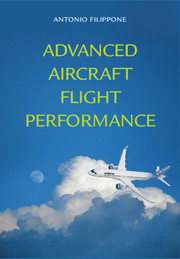Book contents
- Frontmatter
- Contents
- Tables
- Preface
- Nomenclature
- Technology Warning
- 1 Prolegomena
- 2 Aircraft Models
- 3 Weight and Balance Performance
- 4 Aerodynamic Performance
- 5 Engine Performance
- 6 Propeller Performance
- 7 Airplane Trim
- 8 Flight Envelopes
- 9 Take-Off and Field Performance
- 10 Climb Performance
- 11 Descent and Landing Performance
- 12 Cruise Performance
- 13 Manoeuvre Performance
- 14 Thermo-Structural Performance
- 15 Mission Analysis
- 16 Aircraft Noise: Noise Sources
- 17 Aircraft Noise: Propagation
- 18 Aircraft Noise: Flight Trajectories
- 19 Environmental Performance
- 20 Epilogue
- Appendix A Gulfstream G-550
- Appendix B Certified Aircraft Noise Data
- Appendix C Options for the FLIGHT Program
- Index
- References
2 - Aircraft Models
Published online by Cambridge University Press: 05 January 2013
- Frontmatter
- Contents
- Tables
- Preface
- Nomenclature
- Technology Warning
- 1 Prolegomena
- 2 Aircraft Models
- 3 Weight and Balance Performance
- 4 Aerodynamic Performance
- 5 Engine Performance
- 6 Propeller Performance
- 7 Airplane Trim
- 8 Flight Envelopes
- 9 Take-Off and Field Performance
- 10 Climb Performance
- 11 Descent and Landing Performance
- 12 Cruise Performance
- 13 Manoeuvre Performance
- 14 Thermo-Structural Performance
- 15 Mission Analysis
- 16 Aircraft Noise: Noise Sources
- 17 Aircraft Noise: Propagation
- 18 Aircraft Noise: Flight Trajectories
- 19 Environmental Performance
- 20 Epilogue
- Appendix A Gulfstream G-550
- Appendix B Certified Aircraft Noise Data
- Appendix C Options for the FLIGHT Program
- Index
- References
Summary
Overview
In this chapter, we present methods for the determination of the geometrical configuration of a modern transport aircraft (§ 2.1). We use the concept of control points and geometric wire-frames (§ 2.2). Thus, we establish a framework for the determination of linear dimensions, position of centroids, reference areas and volumes. The methods shows are valid for any other type of aircraft. We use a stochastic approach for more complex surfaces (§ 2.2.1). Section 2.3 deals with the geometry of the lifting surfaces. We then show a method for the determination of the wetted areas (§ 2.4), aircraft volumes (§ 2.5), including the wing tanks, and the mean aerodynamic chord (§ 2.6). We produce a few examples of verification of aircraft configurations (§ 2.7). Finally, we define some reference systems on the aircraft (§ 2.8).
KEY CONCEPTS: Transport Aircraft, Geometry Definition, Wetted Areas, Aircraft Volumes, Fuel Tanks, Mean Aerodynamic Chord, Reference Systems.
Model for Transport Aircraft
The aircraft geometry represents the basis of all of the aerodynamic calculations, fuel and payload capacity, centre of gravity position, stability and control requirements. The construction of an accurate aircraft model is done in a number of steps that require the choice of reference systems, the determination of the key sub-systems, and an assembly procedure to determine the geometric relationships between parts of the vehicle. Various reference systems are introduced to define geometrical relationships and operational conditions in flight. The procedures shown in this chapter are required to calculate reference areas, reference lengths and reference positions for a wide variety of calculations.
- Type
- Chapter
- Information
- Advanced Aircraft Flight Performance , pp. 16 - 44Publisher: Cambridge University PressPrint publication year: 2012



